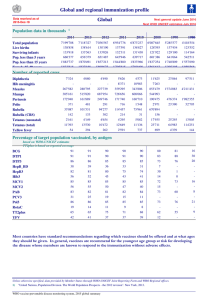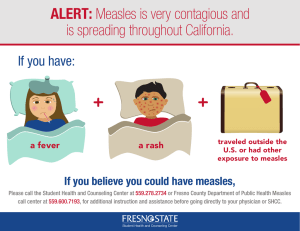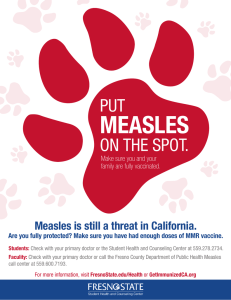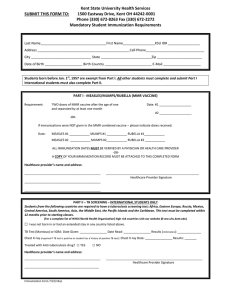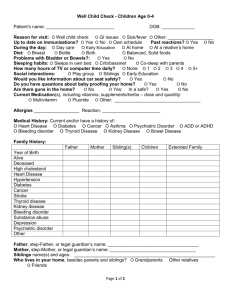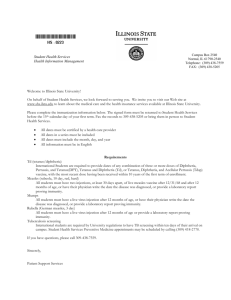Document 14845981
advertisement
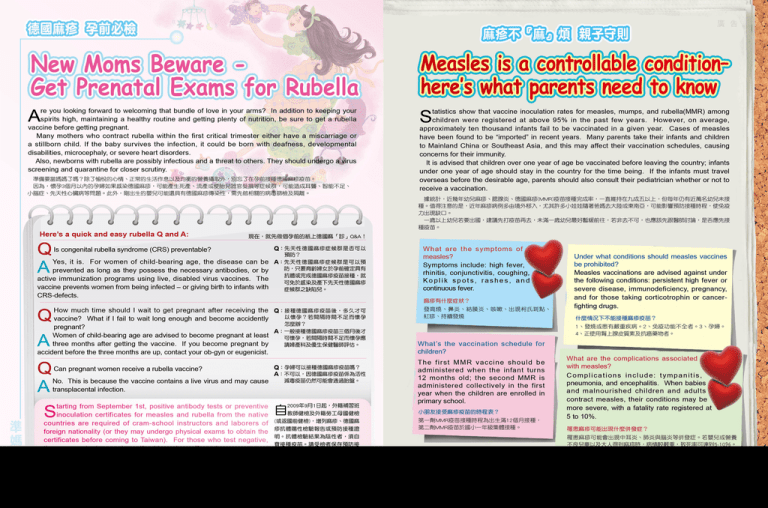
Polio, Measles, Congenital Rubella Syndrome and Neonatal Tetanus Eradication Programs Background Taiwan launched the polio, measles, congenital rubella syndrome, and neonatal tetanus eradication program in 1991. The goal of poliomyelitis eradication had already been achieved on October 29, 2000. The vaccination coverage rate of OPV3 keeps more than 95% in Taiwan. However, the risk of wild poliovirus importation remains as long as polio exists anywhere in the world. The maintenance of polio eradication is still an important strategy. As one of the vaccine-preventable diseases, measles elimination is considered as an accomplishable goal through immunization strategy. The annual confirmed cases of measles in Taiwan are less than 10 in recent years, except 24 cases in 2002. As for neonatal tetanus there is no longer any reporting case since 1995, but a confirmed case whose mother was foreign nationality happened again in 2001. In addition, congenital rubella syndrome had been no case also for several years since 1994, but 3 confirmed cases and 1 confirmed case were reported in 2001 and 2007. Cases among them whose mother was foreign nationality were three. Therefore, we can be aware of the impacts of interactions of business affairs, travel internationally, foreign laborers introducing, and foreign or continent wives accruing day by day on the infectious disease burden of Taiwan in recent years. The potential risk of those diseases resurging in community can't be ignored definitely. So it is necessary to advance the sustaining progress of “Polio, Measles, Congenital Rubella Syndrome and Neonatal Tetanus Eradication Programs”. Goal and Strategies 1. Sustaining high vaccination coverage rate of various vaccines The strategies are as following: ‧Ensuring access conveniently to immunization service provided by contract hospitals, clinics. ‧Improving the quality of immunization service. ‧Carrying out the surveillance of vaccination coverage rate. ‧Implementing appropriate campaigns on district of low coverage rate. ‧Ensuring that the women of childbearing age (especially foreign nationality) have sufficient immunity against rubella. ‧Practicing well cold chain management of vaccine delivery system. ‧Improving the national information of immunization system. 2.Strengthening the sensitivity of the disease surveillance system Both highly sensitive surveillance for acute flaccid paralysis (AFP), measles, rubella, and congenital rubella syndrome and data analyses in line are critical to detect wild virus circulation. Interventions such as enhancing the report and follow-up activities on cases delivered beyond the hospital in order to find out the potential neonatal tetanus cases, carrying on zero case notifying system by active telephone interview, assessing surveillance performance of every county’s health unit irregularly and monitoring the progress of operation schemes, and having the health unit inferior to others to propose reforming plans and measures for addressing the problems, in addition, include the measure of incentive payments to persons who notify infectious case should be enforced. 3.Strengthening the performance of laboratory Beside the role of identification of the suspect case by laboratory serological diagnosis, development of laboratory strategies at different measles control and elimination stages according to World Health Organization suggestion is undertaken since 2002. Setting up virus culturing methods and molecular biologic diagnosing technology are the two major tasks. For accurate analyses of serum antibody test and virus isolation from collected specimens, there are specific requirements for types, timeliness and number of the samplings should be followed. 4. Improving completeness and reliability of the case investigation Except that the specimen collection methods must comply with the specific requirements, critical steps of the case investigation must also include vaccination status, travel history, and investigation of any symptoms of suspected contact. All activities must follow the standard operation procedures documented beforehand, in order to enhance the personnel training of local health care unit. 5.Health advocacy for community Declaring through multiple channels, remind the parents having their children inoculate vaccine on time, especially focus on foreign and continent spouses. 6.Carrying on the related researches Expand the scope of studies for the isolation, identification of wild measles virus, rubella virus, carry on the molecule biological study such as viral gene sequencing of measles isolates in order to set up genomic database, evaluate serological epidemiology and benefit assessment of national immunization information system, vaccination coverage rate, etc are necessarily. Accomplishments 1. In 2007, 58 AFP cases under the age of 15 were reported and investigated. Investigations completed within 48 hours were 100% . Clinical data showed none of them were polio cases. 2. In 2007, 85measles cases were reported. Both the investigating rate and the sampling rate were 100%. Ten cases were confirmed to be measles. 3. Three suspected CRS were reported in 2007. Investigations and complete samplings were made. Only one case was confirmed. 4. One suspected neonatal tetanus case was reported in 2007. None of the cases involved the babies not born in hospital through tracing. 5. Since 2002, foreign (and mainland Chinese) female spouses have been required to obtain an updated rubella/immunization certificate. Visions 1. Preventing the events of poliovirus importation in order to sustain polio-free achievement in Taiwan. 2. Development of policy drafts for the mainstream of global post-certification of polio eradication. 3. Developing active surveillance through analyzing the specimen collected from the contract viral laboratory to look for all the possible cases of measles. 4. Achieving the target of the certification of measles elimination in coordination with World Health Organization measles elimination progress. 5. Sustaining zero case achievement of congenital rubella syndrome and neonatal tetanus.
